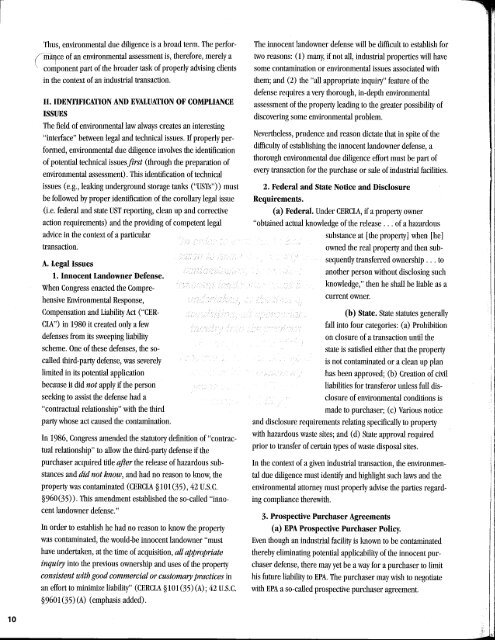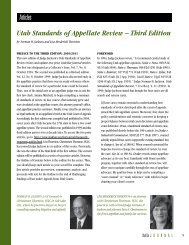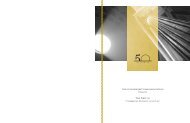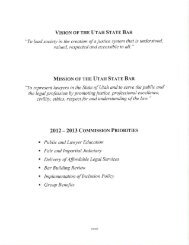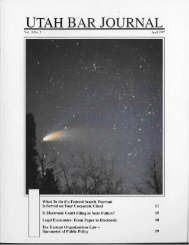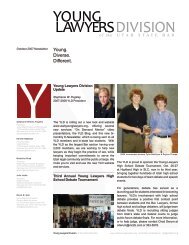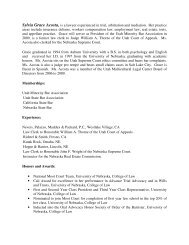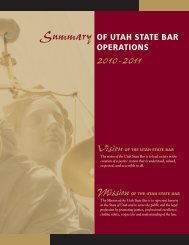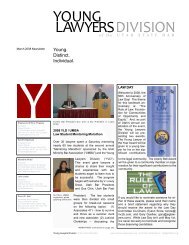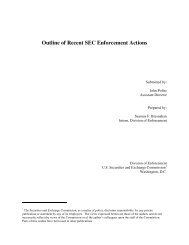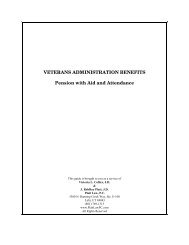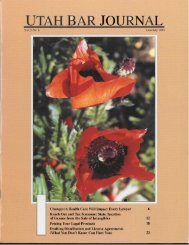March 1999 Volune 12 No3 - Utah State Bar
March 1999 Volune 12 No3 - Utah State Bar
March 1999 Volune 12 No3 - Utah State Bar
You also want an ePaper? Increase the reach of your titles
YUMPU automatically turns print PDFs into web optimized ePapers that Google loves.
I<br />
10<br />
Thus, environmental due digence is a broad term. The perfor-<br />
(ri~ce of an environmental assessment is, therefore, merely a<br />
\ component part of the broader task of properly advising clients<br />
in the context of an industrial transaction.<br />
II. IDENTIFICATION AND EVALUATION OF COMPLIACE<br />
ISSUES<br />
The field of environmental law always creates an interesting<br />
"interface" between legal and techncal issues. If properly per-<br />
formed, environmental due digence involves the identifcation<br />
of potential techncal issues<br />
first (through the preparation of<br />
environmental assessment). This identication of techncal<br />
issues (e.g., leakig underground storage tanks ("USTs")) must<br />
be followed by proper identifcation of the corollary legal issue<br />
(i.e. federal and state UST reporting, clean up and corrective<br />
action requirements) and the providing of competent legal<br />
advice in the context of a particular<br />
transaction.<br />
A. Legal Issues<br />
1. Innocent LandownerDefense.<br />
When Congress enacted the Compre-<br />
hensive Environmental Response,<br />
Compensation and Liabilty Act ("CER-<br />
CLA") in 1980 it created only a few<br />
defenses from its sweeping liabilty<br />
scheme. One of these defenses, the so-<br />
caled thid-par defense, was severely<br />
limited in its potential application<br />
because it did not apply if the person<br />
seeking to assist the defense had a<br />
"contractual relationship" with the thid<br />
part whose act caused the contamnation.<br />
In 1986, Congress amended the statutory definition of "contrac-<br />
tual relationship" to alow the third-party defense if the<br />
purchaser acquired title after the release of hazardous sub-<br />
stances and did not know, and had no reason to know, the<br />
propert was contamated (CERCLA §101(35), 42 U.S.C.<br />
§960(35)). This amendment established the so-caled "inocent<br />
landowner defense."<br />
In order to establish he had no reason to know the property<br />
was contamnated, the would-be innocent landowner "must<br />
have undertken, at the time of acquisition, all appropriate<br />
inquiry into the previous ownership and uses of the propert<br />
consistent with good commercial or customary practices in<br />
an effort to mimize liabilty" (CERCLA § 101 (35) (A); 42 U.S.C.<br />
§9601 (35) (A) (emphasis added).<br />
The innocent landowner defense wil be dicult to establish for<br />
two reasons: (1) many, if not al, industrial properties wil have<br />
some contamiation or environmental issues associated with<br />
them; and (2) the "all appropriate inquiry" feature ofthe<br />
defense requires a very thorough, in-depth environmental<br />
assessment of the property leading to the greater possibilty of<br />
discovering some environmental problem.<br />
Nevertheless, prudence and reason dictate that in spite of the<br />
difculty of establishing the innocent landowner defense, a<br />
thorough environmental due diligence effort must be part of<br />
every transaction for the purchase or sale of industrial facilties.<br />
2. Federal and <strong>State</strong> Notice and Disclosure<br />
Requirements.<br />
( a) FederaL. Under CERCLA, if a property owner<br />
"obtained actual knowledge of the release. . . of a hazardous<br />
substance at (the property J when (he J<br />
owned the real propert and then sub-<br />
sequently transferred ownership . . . to<br />
another person without disclosing such<br />
knowledge," then he shal be liable as a<br />
current owner.<br />
(b) <strong>State</strong>. <strong>State</strong> statutes generaly<br />
fall into four categories: (a) Prohibition<br />
on closure of a transaction unti the<br />
state is satisfied either that the property<br />
is not contamiated or a clean up plan<br />
has been approved; (b) Creation of civil<br />
liabilties for transferor unless full dis-<br />
closure of environmenta conditions is<br />
made to purchaser; (c) Various notice<br />
and disclosure requirements relating specifcaly to properly<br />
with hazardous waste sites; and (d) <strong>State</strong> approval requied<br />
prior to transfer of certn tyes of waste disposal sites.<br />
In the context of a given industrial transaction, the environmen-<br />
ta due digence must identif and highlight such laws and the<br />
environmental attorney must properly advise the parties regard-<br />
ing compliance therewith.<br />
3. Prospective Purchaser Agreements<br />
(a) EPA Prospective Purchaser Policy.<br />
Even though an industrial facilty is known to be contaated<br />
thereby eliminating potential applicabilty of the innocent pur-<br />
chaser defense, there may yet be a way for a purchaser to limit<br />
his future liabilty to EPA. The purchaser may wish to negotiate<br />
with EPA a so-caled prospective purchaser agreement.<br />
1','


